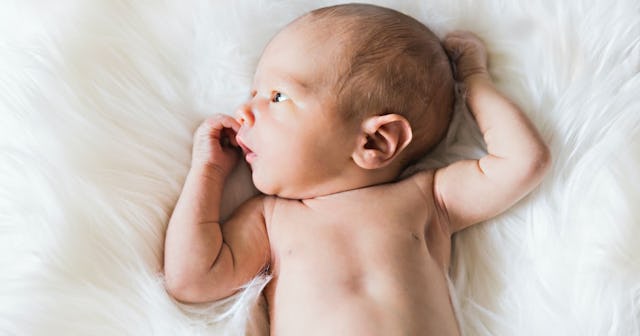How Many Bones Do Babies Have?

Check out more from our Baby & Toddler Development package to read more about thrush in babies, jaundice, baby hiccups, why babies look bow legged, baby kneecaps, toddler flat feet, and newborn eye color.
When you gaze adoringly upon your newborn, you’re probably thinking about how precious their teeny tiny toes are. Or how you could just gobble up their wittle fingers. You may even be marveling over how perfectly round your little pumpkin’s head is. And maybe all of those oh-so-cute bits and baby baubles make you wonder, How many bones does a baby have? Because looking at your newborn, it’s easy to imagine they’re basically just one big squishy lump of pure love.
In reality, though, the newborn you’re holding in your arms has even more bones than you do. Curious? You’re not alone. According to the most recent search data, the term “how many bones does a baby have” has a search volume of nearly 12,000 a month! A MONTH! Here’s the scoop on this fascinating topic.
How many bones do adults have?
Before we reveal the number of bones your baby is born with, it makes sense to give this conversation some context. So, consider this: Adults have 206 bones, accounting for about 15 percent of their body weight.
How many bones does a baby have?
Now, for the good stuff! Drumroll, please… a baby is born with roughly 300 bones in their body. Wait, what?! How could something so tiny contain so many bones? As in, almost 100 more than an adult? We’ll get into that more in a minute. But it merits mentioning that newborns have 176 true bones and the remainder of the roughly 300 are called cartilaginous bones, meaning they have not yet calcified. For example, did you know babies are kind of, basically born without kneecaps? That’s right, kneecaps don’t solidify into bones until children are about 10 or 12 years old, before then, knee caps are made of cartilage and fatty tissue. No wonder kids can crawl on their knees without it hurting them or damaging their legs.
Why do babies have more bones than adults?
You now know that babies’ skeletons have 300 parts. What you don’t know yet is why. Well, for starters, if a baby was fully “hardened” at birth, it would render labor and delivery pretty much impossible. Cartilage is soft and flexible, giving baby pliability in the birth canal and as they continue to grow.
As for why there are “extra” bones, the cartilaginous “bones” just haven’t fused together yet. Once they do, they combine to form a greater bone. In other words, many minuscule bone fragments fuse to form a single bone. Say, for example, baby’s skull. You’ve probably been warned a million times not to mess with the “soft spot” on your little one’s dome. These soft spots, known as fontanelles, exist in the space where cartilage hasn’t yet fused into bone. If your baby is born with eight small pieces of bone in their skull, they will eventually reduce to four bones in the skull.
This hardening over time is a process known as endochondral ossification.
At what age do babies’ bones fuse together?
Here’s a fun fact: A baby’s bones won’t fully fuse together while they’re a baby. In fact, the process of ossification and bone growth won’t stop until early adulthood — usually around the age of 25. At this point, you’ll have 206 bones that are as big as they will ever be.
However, this doesn’t mean your bones are just going to kick back and chill from then on. In a process called remodeling, they’ll form new bone tissue and break down older bone into calcium and other minerals to be released into the bloodstream. That part of the process is called resorption. And if you really want your mind to be blown, mull this over: Your skeleton completely regenerates itself every decade or so through remodeling.
Want more facts about the skeleton to blow your mind? We have some for you:
- There are 26 bones just in your foot.
- 1/4 of the bones in your body are in your feet.
- The arm is the most commonly broken bone in adults. That honor goes to the collarbone when it comes to children.
What are growing pains in children?
If you’ve ever asked Dr. Google why your little one has been waking in the middle of the night complaining of pain in their legs you may have come across the term “growing pains.” The term is left over from the 1930s and 1940s but we now know growth spurts in children don’t actually cause pain. The symptoms of growing pains are a throbbing pain in the legs, and they often occur at night to kids between the ages of 2 and 12.
Per the Cleveland Clinic, experts don’t know the cause of these pains but some theories point out that “children with these pains are very flexible (hypermobile) with flat feet. Some children with these pains have a low pain threshold and may also have headaches and abdominal pain. One study found that children with these pains have less bone strength than the normal population. Therefore, pain on a day of increased physical activity may mean the child may have pain from ‘overuse’ of the legs.”
This article was originally published on